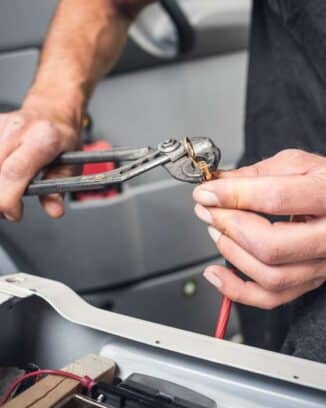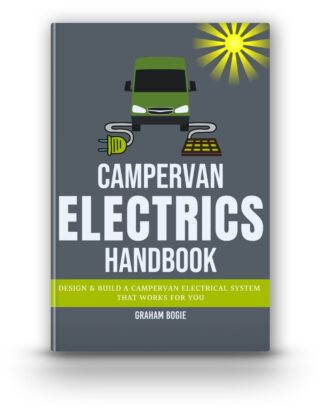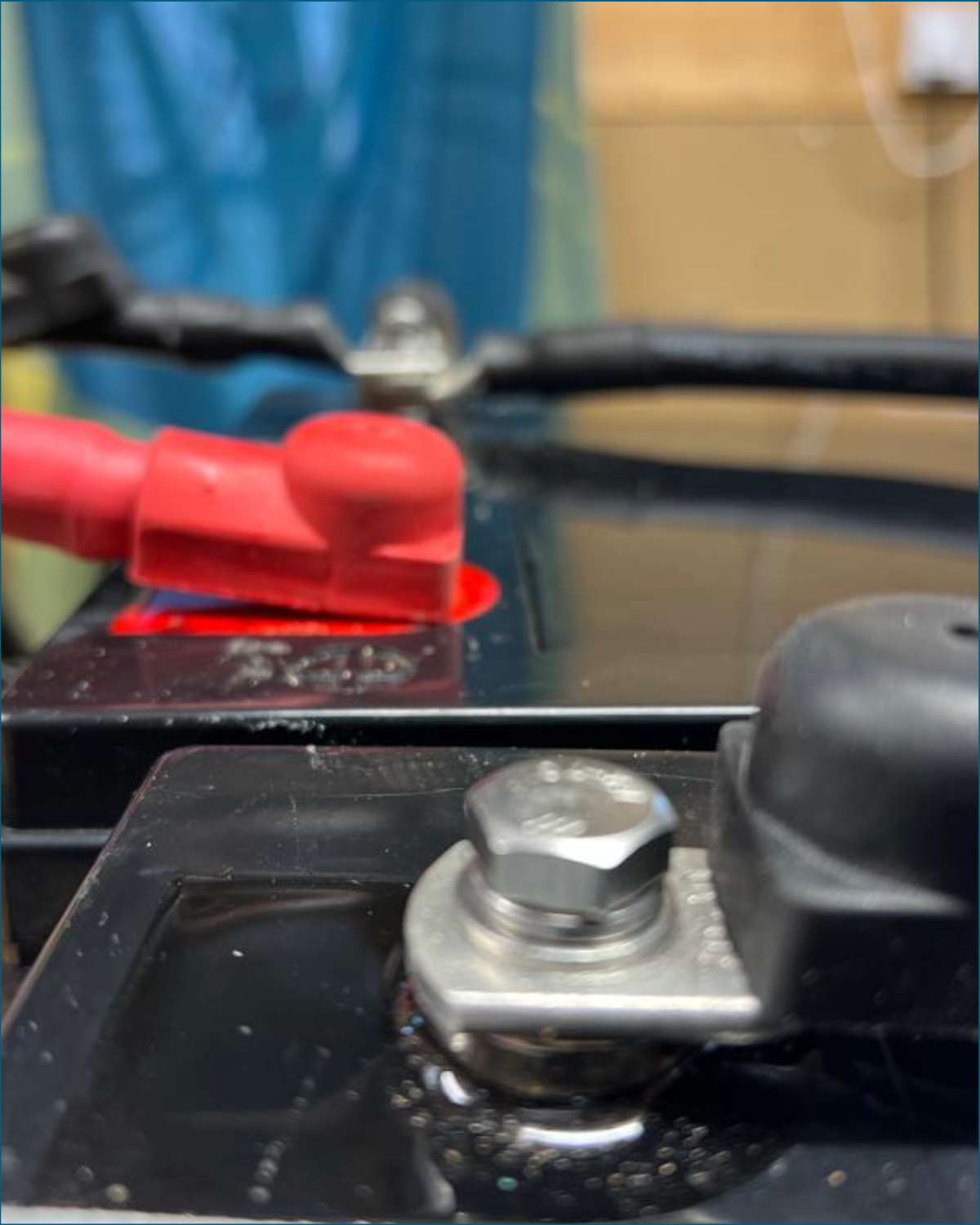This RV solar calculator will help you correctly size your entire camper solar system. It includes your inverter, solar panels, solar charge controller and battery bank too.
It’s simple and straightforward to use. We’ve included a section below to answer some questions you may have.
This calculator forms part of our camper solar setup series and the wider subject of campervan electrics.
And it’s just one of our electrical calculators for RVs and campervan conversions too.
And it’s just one of our electrical calculators for RVs and campervan conversions too.
Calculating the minimum size of your RV solar system is a major step in finalising your electrical design.
Get this right and you can complete your DIY campervan conversion with confidence.

Need help & advice with your electrical setup?
Join Our Facebook Support Group

Everything you need to know about campervan electrics. Now available in ebook and paperback!
Learn how to design, size, install and troubleshoot your camper’s electrical system.
Questions
- How do I use this solar battery bank calculator?
- How do I know all the electrical devices I’ll use?
- I won’t use every appliance everyday. What should I do?
- How do I find the watts of each device?
- How do I know my appliance is AC or DC?
- I have more than 5 devices. What shall I do?
- I have more than 25 devices. What shall I do?
- Why is the calculated watts bigger for AC?
- I already know my total load in watt hours. Can I still use the calculator to size battery?
- How much contingency do I need?
- What is the difference between Gel, AGM, FLA and Lithium Batteries?
- How much battery should I install?
- What Peak Sun Hours Should I Select?
- What is the difference between a PWM and MPPT charge controller?
- What Solar Charge Controller should I install?
- Do I need an inverter?
- The inverter size calculated is smaller than I expected. Why?
- What do I do next?
How do I use this solar battery bank calculator?
- Enter every electrical device and component you’ll power form your camper batteries
- Enter the watts each device uses
- Enter the maximum number of hours each day you’ll use the device
- Select whether each device is DC or AC
- Enter the amount of contingency you want to add to the total usage
- Select the battery type you will install
- Select the minimum expected peak sun hours
- Select the type of solar charge controller
The RV solar calculator provides the minimum size solar components needed based on the information entered.
How do I know all the electrical devices I’ll use?
Getting a complete list of electrical appliances, devices and components you’ll use in your RV is the most critical part of sizing the electrical system.
Underestimate it and you may run out of power.
Overestimate and you’ll probably spend more money and make your setup more complex than necessary.
Work through your typical day, considering all the appliances you’ll use along the way.
Don’t forget any gas or diesel appliances that need power to start them up.
I won’t use every appliance everyday. What should I do?
The aim of the calculation to size your camper electrical setup so you have enough power every day.
With this in mind, it’s important to consider your most heavy usage day.
Maybe you intend to live in your camper during the winter.
Your heating will run for longer and probably your ventilation fan too (it’s the best way to stop condensation).
You may be living indoors much more and with fewer hours of daylight than during the summer months. All this adds up to greater energy demands.
Think it through carefully. It’s not going to be 100% accurate but you can get close enough.
How do I find the watts of each device?
The watts of most devices can be found either printed on the device, in the operating manual or the manufacturer’s website online.
Sometimes, products list the power usage in current (i.e. amps). In this case, use the wattage calculator at the top of the solar calculator above to convert the current and volts to watts.
The way the power is stated on devices isn’t standard. Look out for things like:
- Power: 12V/2.5A
- Voltage: 12v Wattage: 25w
- Amp Draw 12V/DC: 4.2
For some devices, in particular those with battery charging adaptors like camera batteries and laptops, use the input values specified not the output values.
If you can’t find the power of the device easily, a watt meter is a low cost tool to help you get an accurate reading.
Simply plug the meter into your household socket, plug the device into the meter and switch on the device.
The read out display will give you the watts used. Make sure the device is operational for the maximum reading.
How do I know my appliance is AC or DC?
The labels or specification of most appliances state whether it is AC or DC.
Failing that, if it has plug you can use in your home sockets, it is probably an AC appliance.
For calculation purposes, if in any doubt, assume it is AC as this produces a higher number so errs on the side on caution.
I have more than 5 devices. What shall I do?
If you have more than 5 devices to list follow these steps:
- Enter the 1st 5 devices
- Press the “add more devices” button
- A further 5 rows are displayed for your to add more devices and another “add more devices” button after each set
You can add upto 25 devices in total.
I have more than 25 devices. What shall I do?
If you have more than 25 devices to list follow these steps:
- Split the appliances between AC and DC
- Enter the 1st 25 DC appliances
- Change the contingency value to 0%
- Make a note of the Daily Power Usage figure
- Refresh the page in your browser to reset the calculator
- Enter the 1st 25 AC appliances but enter them as DC
- Change the contingency value to 0%
- Make a note of the Daily Power Usage figure
- Refresh the page in your browser to reset the calculator
- Enter the 1st device as the total of the first 25 DC devices
- Watts = Wh you noted down
- Hours = 1
- DC or AC = DC
- Enter the 2nd device as the total of the first 25 AC devices
- Watts = Wh you noted down
- Hours = 1
- DC or AC = AC
- Add your additional devices
Why is the calculated watts bigger for AC?
AC appliances need AC power but camper batteries produce DC power.
The DC power is converted via the inverter to AC power but there is a cost of this conversion. As such, AC appliances use a greater power factor in the solar battery bank calculator.
I already know my total load in watt hours. Can I still use the calculator to size battery?
Yes.
If you already know your total load in watt hours, enter 1 device with the total watt hours in the watt field, 1 hour and list it as DC.
If you list it as AC, the calculator will increase the watt hours further and size an inverter too.
How much contingency do I need?
How much contingency you want to include is completely upto you.
We’ve always used about 20% and it has served us well.
If you don’t rely on your electrical system, consider reducing it a little.
If unsure of your power use or appliances, consider increasing the contingency – you’ll never complain about having too much battery.
You can deduct contingency too by using a negative number. The calculator will warn you the value should be a positive number but will calculate accordingly.
What is the difference between Gel, AGM, FLA and Lithium Batteries?
Battery technology varies widely and advancements are being made all the time.
Currently, the most commonly installed batteries are Gel, AGM or Lithium. FLA use dated technology and we recommend steering clear of them.
Lithium batteries are significantly more efficient than Gel or AGMs so can be discharged to a much lower level.
This explains why you need a smaller Lithium battery than either AGMs or Gels.
But this doesn’t mean a lithium battery is always the best option.
To assess which battery is most cost effective and best suits your needs, use our battery comparison calculator.
More information, read our detailed post on campervan batteries.
How much battery should I install?
The calculator states the minimum size solar battery bank you need to provide the load you’ve indicated.
However, if you only install that amount of battery, you must have the ability to fully recharge them every day.
Otherwise, you’ll discharge your batteries faster than you can top them up and end up with flat batteries pretty soon.
If you have a reliable source of recharging, like a hook up facility to shore power, you may not need any extra battery.
But if living off grid and rely on charging the leisure batteries from solar panels or the alternator, you may need to consider increasing the amount of battery.
Whatever you decide, there is no point installing a battery bank greater than you can reasonably expect to charge.
What Peak Sun Hours Should I Select?
The amount of sun falling on your solar panels affects how much energy they can harvest.
Because the sun’s position in the sky varies throughout the year, the amount of energy they can harvest also varies.
Use our peak sun hours calculator for each area you plan to travel.
Use the lowest number of all the locations you will travel to.
What is the difference between a PWM and MPPT charge controller?
The main differences between a PWM and MPPT charge controllers is price and efficiency ratings.
A PWM controller is low cost but even when performing at its peak, isn’t especially efficient.
If you want (or need) a solar charge controller to squeeze as much juice out of the wattage on the panels, a highly efficient MPPT controller is the way to go.
You can read more about the differences between PWM and MPPT charge controllers in this post.
What Solar Charge Controller should I install?
A solar charge controller should be sized for the size and configuration of your solar array.
The calculator above provides the minimum size needed.
When you know what solar panels you’ll install, use our solar charge controller calculator to find the right size and model for your set up.
Do I need an Inverter?
You only need an inverter if you want to use AC appliances powered by your deep cycle battery.
If you use AC appliances only when hooked up and have AC sockets on the mains circuit, you don’t need an inverter.
Check out our detailed article on campervan inverters for more info.
The inverter size calculated is smaller than I expected. Why?
Running AC appliances on a solar system demands a lot of energy from the batteries.
Keeping the number of AC appliances to a minimum will help keep the size of the system down.
We’ve calculated the inverter size to run only your largest AC appliance with no other AC appliances running at the same time.
If you already have a larger inverter, use that but keep your maximum load as low as possible or you’ll drain the batteries fast.
For more information and to understand the implications of a large inverter on your solar system, check out our inverter calculator.
What do I do next?
So now you have an idea of the kind of size solar system your expected load needs what are the next steps?
Step 1 – Cut back on electricity use
If this is your first attempt at sizing your camper solar setup, you may find the result is a pretty big system.
Living in a van isn’t the same as living in a house. We need to be more frugal with our resources.
The first thing to do is check you have enough space on the RV roof for all the solar panels.
If not, or the system is much bigger than you expected, it’s time to reassess you energy needs.
Try swapping out AC appliances for DC alternatives, look for less powerful devices and replace electric devices for non electrical versions.
Re-run the calculations above for revised sizing.
Step 2 – Draw up a Solar Panel Wiring Diagram
Drawing out a wiring diagram will help identify the components you need to install it.
Check out our solar panel wiring diagrams (for free). Choose the size closest to your solar panel set up. Each has a complete list of the components needed.
Step 3 – Select the Solar Panels
Choose your solar panels.
There’s a number of different types and you can read more about them in our camper solar panels post.
Once you’ve selected the type of panel, measure the available space on the roof so you know what sizes to buy.
Check the technical spec of the panels before you move onto the next step.
Step 4 – Decide if you’ll wire the panels in series or parallel
A solar array wired in parallel produces a much higher current than when wired in series.
When wired in series, the solar array produces much higher voltages.
Each of the scenarios have their advantages and disadvantages, especially when installed in a campervan for off-grid living.
You can read more about wiring solar panels in series and parallel here.
Step 5 – Select a Solar Charge Controller
Now you know the exact solar panels you’ll use and how you’ll wire them, you can accurately size the solar charge controller.
Our Solar Charge Controller Calculator will provide you with the right size and recommended controller too.
Step 6 – Choose the Battery Type
Deep cycle leisure batteries come in a number of technologies – Lithium, AGM and Gel. You can read more about the pros and cons in our post on campervan batteries.
While Lithium are the latest most efficient, they’re also the most expensive. In fact, if you only intend to own your camper for a couple of years, they’re not the most cost effective either.
If you want to compare batteries to help find the most cost effective for your setup, use our battery life calculator before you buy.
Step 7 – Install your Solar System
Follow our step by step guide on how to install solar panels on RVs and campers and you’ll be living off grid in no time.
Graham Bogie

Graham is a seasoned marine electrical engineer with two decades of experience designing customized electrical systems for plant machinery and converting campers and overland vehicles. His expertise has led him to author the reputable Campervan Electrics Handbook and become the chief designer of the RV Wiring Design Tool. As a knowledgeable figure in the field, his YouTube channel, blog, Facebook group, and newsletter, offering electrical advice and product reviews, reach more than a million users each year.




Hi folks,
I’m renovating/redesigning the interior of my 96 Thor Pinnacle camper from scratch.
I’m using lightweight materials, multi-purpose furniture like a Murphy bed/desk.
Designed a circulating shower. I’m installing energy-efficient appliances.
No propane a normal household mini fridge and freezer, infrared floor heating, no furnace. Induction cooking …
I made a rough calculation (can’t upload a pic or pdf)and I need about 21 kwh 300 Amps to power all this.
I’m planning to install 6 x 200w flexible mono ETFE solar panels and 3 200Ah LiFePO4 Lithium Batteries.
I know that the lifespan of flexible solar panels is not that great but cutting the weight is something that I consider.
I’m planning to travel from May till September around the Mediterranean.
So my question is, is my solar setup enough or overkill ?
Hi, unless I’m mistaken there is a flaw in your calcs for the power. If I select a 2000w DC item for .5 hr per day I get an Inverter of 1200w.
When I change this to run for 1 hour per day get an Inverter of 2400w.
When I change this to run for 2 hour per day get an Inverter of 4800w.
I understand that I will need more battery, and solar, but simply running a device that uses a constant power draw does not change the size of the inverter? Or do I miss the point?
Cheers
Hi Colin – The inverter size shouldn’t change regardless of how long you use the device. Can you please double check your entries again? Please make sure you’ve selected AC for the device. I can’t replicate the problem you’ve described. If you still see the issue when you re-enter the numbers, it’d be super helpful if you could send us a a screen shot so we can investigate further. Thx